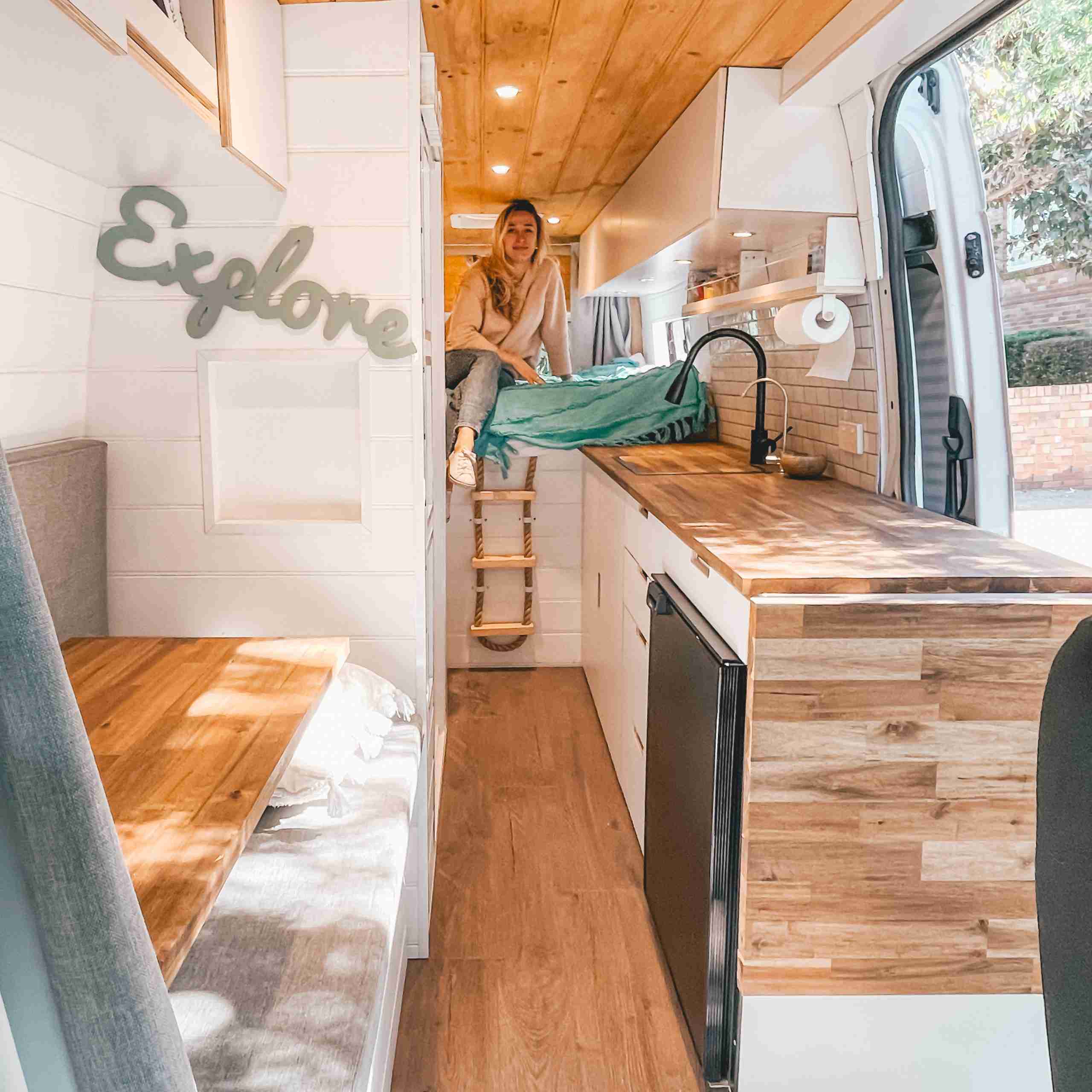Camper Van Layout Guide: How to Design your Dream DIY Van Conversion
Your camper van design will have a significant influence on your comfort, storage capacity and mobility.
Your van is an important aspect of van life, but it’s also just a vehicle – van life is really all about the experience of being out there. And we’re here to assist you in transforming your van into a home so that you may get on the road as soon as possible!
In this article, we’ll be looking at how to design the layout of your camper van build. Whether you’re living in it full-time or just as a weekend getaway, there are some key considerations to keep in mind when designing the best van layout ideas.
- Choosing Your Van
- 16 Things to Consider For Your Camper Van Conversion Layout
- 1. What is your budget?
- 2. Is this going to be your full-time home or used for shorter trips?
- 3. What will the weather be like
- 4. How many people will be living or travelling in your van?
- 5. Do you intend to work inside your van?
- 6. Do you prefer a fixed bed or convertible?
- 7. What are your storage space needs?
- 8. Are you planning on a high roof or a standard roof?
- 9. Do you want a toilet?
- 10. Is it a necessity to have a built-in shower?
- 11. Will you be installing new windows?
- 12. What type of ventilation?
- 13. What will you do with the driver and passenger seats?
- 14. Where will you store your food
- 15. Lighting
- 16. Is there anything special you would want to include?
- Search for Inspiration
- Measure Your Van
- Design Your Layout
- Test The Layout
- Frequently Asked Questions
Choosing Your Van
Picking a van for your camper van conversion is the first important step when switching to living in a van. There are many types and models of vans on the market, and the best one for you will be different.
Some vans are better suited for more room, while others are for stealth camping. Some models are better suited to the needs of people who require a lot of extra space in their vans. If you’re reading this page, there’s a good chance you’ll be tackling the van build on your own.
However, if you want something that has already been made for you, there are many companies that are awesome at doing your van build.
We recommend If you’re not sure about the exact make, model, and year of the vehicle you’ll be buying, wait until you have it before spending a lot of time designing your van conversions layout.
16 Things to Consider For Your Camper Van Conversion Layout
Before starting your design, think carefully about what your camper van will be used for and your dreams. Let’s look at some of the most important things to consider before diving into the design:
1. What is your budget?
While we firmly believe that a camper van build is possible on just about any budget. Our van build was on the expensive side at around $25,000. We have seen people do a van build for under $10,000. Your budget will 100% shape your design.
If you’re working with a limited budget, you may not be able to have all of the bells and whistles in your van layout.
2. Is this going to be your full-time home or used for shorter trips?
Living and working in a van full-time requires different requirements than a person who just uses it for short weekend getaways.
Consider how long you’ll be in your van for at any one period.
If you’ve decided to live in your home for at least a year, your living space might look quite different from someone who plans to stay there for a week.
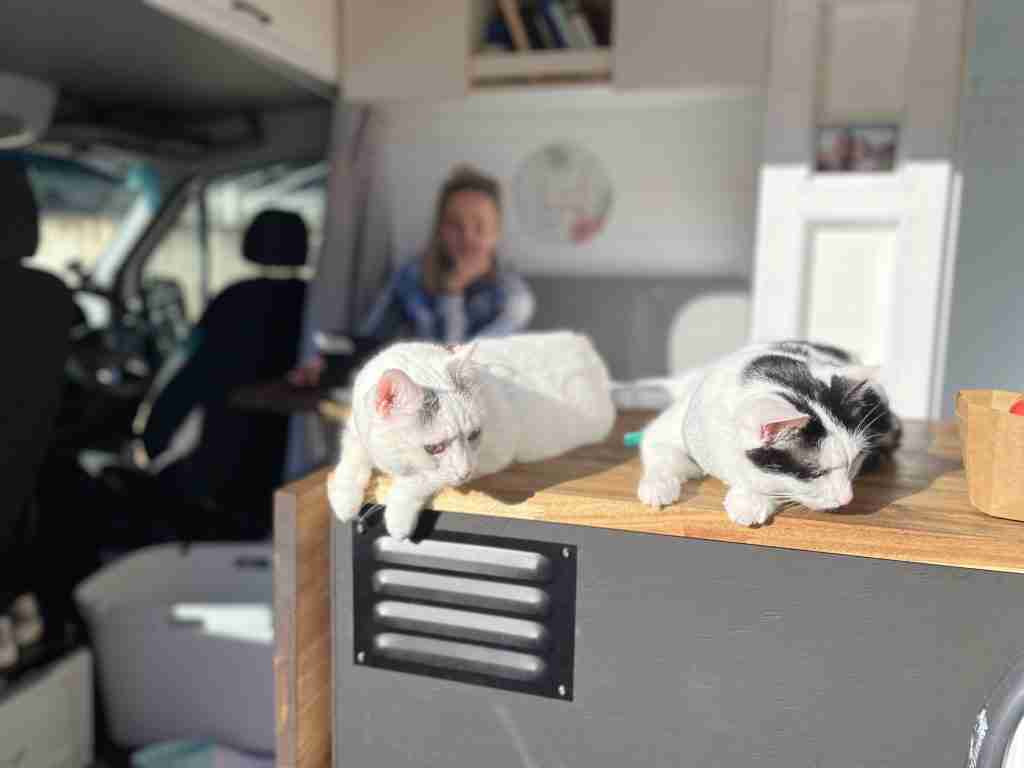
3. What will the weather be like
If you’re planning on visiting areas that are chilly or wet, you’ll be spending a lot of time inside the van. If this is the case, your vehicle will need to be extremely comfy with space to walk about and stand up inside.
However, you may cook outside with minimal issues in the summer, whereas if you are in all-weathers will need counter space for cooking inside. If you are visiting very cold locations, you’ll need to insulate your van correctly on the floor, roof, and sides.
Make sure to factor this in when starting out. If you want to visit extremely hot areas, you’ll need to install two fans on the roof (one fan is usually enough).
If you are going to a cold or chilly place, you will most certainly need a heater and plan for a heater’s storage space.
4. How many people will be living or travelling in your van?
For example, a single person will require a different design than a couple with a cat and a kid.
You’ll need to consider how much storage space you’ll need, what areas will be a living space, and which parts of the van can act as a sleeping space.
5. Do you intend to work inside your van?
Many full-time people doing van life have remote work they can do from the road. If this is the case for you, make sure you’ve planned where you’ll work inside your van. You’ll need to prepare a place to work from, so a convertible bed might be a smart option over a fixed bed, especially if you have a smaller van.
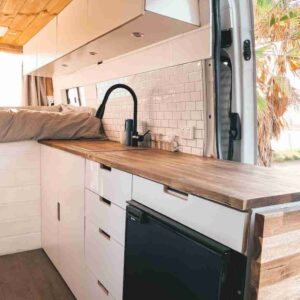
6. Do you prefer a fixed bed or convertible?
A fixed bed will be in “bed mode” at all times, whereas a convertible bed may switch between living space and bed.
If you’re tall, we’d recommend a fixed bed. If you like your space and flexibility, the convertible is the way to go.
Although there are several advantages and disadvantages to each, your bed plan will significantly influence the overall van layout ideas, so this is a big choice.
7. What are your storage space needs?
Do you plan to bring along outdoor equipment gear like mountain bikes or surfboards? You’ll need not as much storage space as someone who does have any of the above.
You’ll need to consider storage space for clothing, kitchen appliances, food and other personal items.
How much storage you’ll need will be significantly impacted by whether your van will be used for full-time travel or if it’s more of a weekend setup.
8. Are you planning on a high roof or a standard roof?
The answer to this question may impact your layout design since you’ll need to change your sizes depending on whether you will be standing or sitting inside your van.
You’ll also need to consider your headspace.
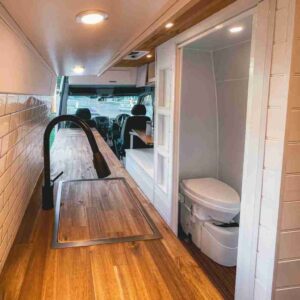
Standard roofs allow for plenty of headspace, and high roofs provide the opportunity for extra storage and living space.
9. Do you want a toilet?
There are several alternatives to choose from, and in all honesty, selecting the right sort of toilet is a highly personal decision.
However, when you begin to plan your layout, consider how much space you want to devote to this area of your camper van.
A private bathroom will require considerably more space than a cassette toilet tucked away in a drawer for when things go wrong. And if you’re serious about adopting a composting toilet (that’s what we have), you’ll want to know how much room it takes up because it isn’t little!
10. Is it a necessity to have a built-in shower?
If you choose “yes”, you’ll have to pick whether you want a corner or conventional shower.
A dedicated bathroom inside your van requires a significant amount of water, so you’ll need to consider that when thinking about your van layout.
It will give you privacy to shower anywhere, but it will take up valuable space.
Honestly, think about how often you plan on using it and remember that there might be limitations as to where you can go.
You may also have an outdoor shower, which takes up little space. However, the disadvantage is that you’ll need to find a location that allows for showering.
11. Will you be installing new windows?
This will likely depend on which van you choose for your camper van conversion.
If you buy a cargo van with no windows, for example, there’s a good chance you’ll want to install one or two to provide some natural light.
However, if you have a van that used to be a passenger vehicle, you may not need to install any. In fact, you may want to even to consider blocking a few windows.
Your decision will affect the placement of your bed, especially if you’re planning on installing a fixed bed.
Since windows take up valuable space on the walls, blocking them could open up other options for an optimal layout.
12. What type of ventilation?
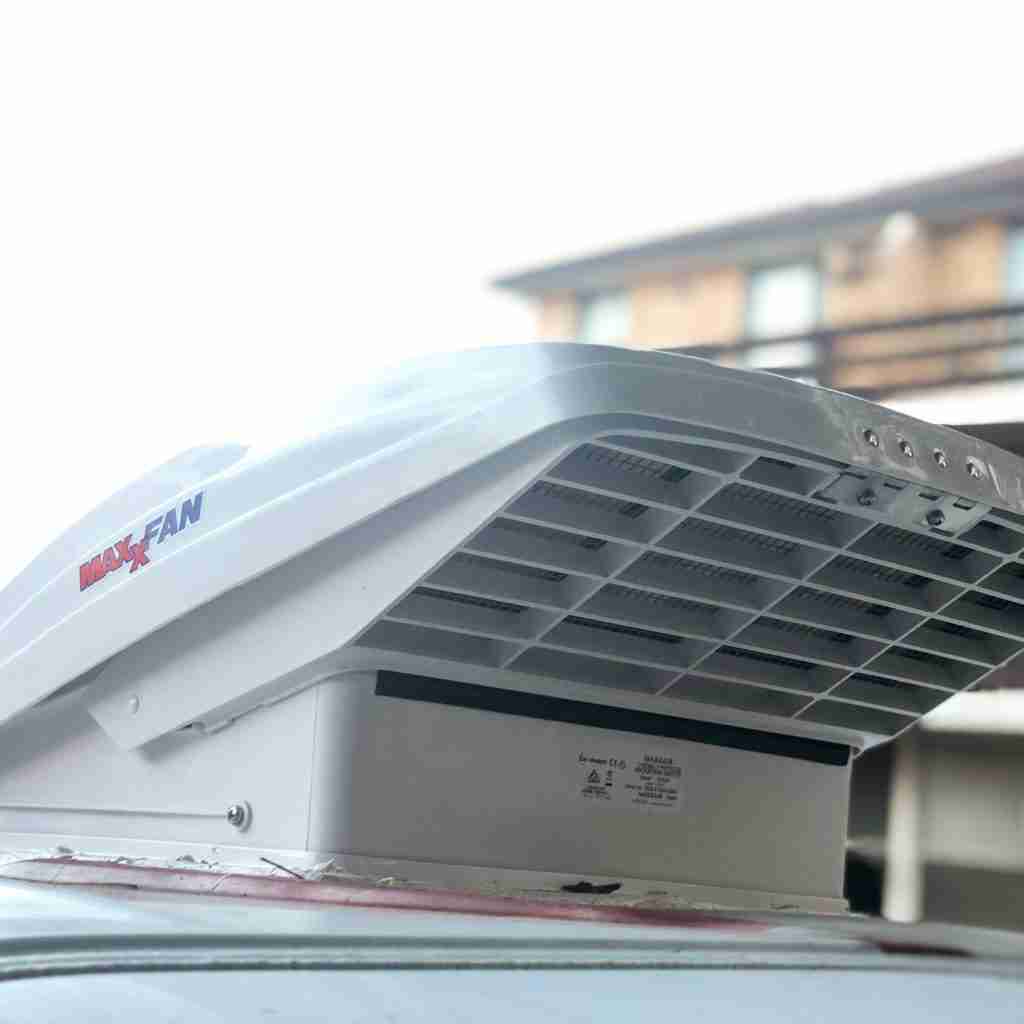
Installing a fan in your camper van will take your comfort to new heights.
It’ll make all the difference in the world between feeling trapped inside a tiny box and having a sense of freedom.
The type of ventilation you choose will significantly impact the layout of your camper van. You’ll need to decide where you want your ventilation.
Installing a fan is not expensive, and the benefits are incredible, especially when it comes to sleeping well at night!
You’ll need to decide where you want the fan installed before you begin. Most people doing van life choose to put a fan above the bed or in the kitchen.
Personally, we installed two fans, one over our fixed bed and one in the kitchen. It helps create circulation when we have one sucking air in and one sucking air out.
Make sure to read over our How we installed a max air
13. What will you do with the driver and passenger seats?
Some people prefer to have them on a swivel, allowing them to have extra seating. However, this limits your ability to build a wall behind the back of the seats.
On the other hand, some people choose to shut off the cab entirely and build right up to the seats, providing more vertical storage capacity. We decided to go with the swivel option to provide additional seating. Plus, if you are in a hurry to move on, you can quickly jump into the driver’s seat.
14. Where will you store your food
If you’re satisfied with baked beans and toast, you may get by with less food storage room. However, for most people, this is not the case. We have two shelves and cardboards full of food in our kitchen and a 130-litre fridge.
Consider how you will keep your food before deciding where to put it. You should also consider the size of the refrigerator you’ll need and what kind of meals do you prepare
15. Lighting
Where you install lights will also affect where you install your overhead storage.
You have more options than just standard lights when it comes to lighting. LED lights are a great option because they use less energy and last much longer than regular bulbs.
You also have the option of installing solar lamps if you’re on a budget or don’t want the hassle of wires everywhere. These will definitely make your space feel larger, as you won’t need to cram all your lighting needs into one place. Keep in mind the solar panels will need to be installed outside for best efficacy.
16. Is there anything special you would want to include?
Maybe A sliding “deck” out the back? A platform on your roof for sunsets and sunrises? A projector to watch movies at night?
Some people have built a hammock to swing from after those extra-long days of driving.
Others have created outdoor cushions so they can enjoy the open air.
Don’t just stick to a standard layout; think outside the box! You’ll be spending a lot of time living in your van, so you want it to be as comfortable as possible.
If you’re just getting started with van life and don’t know what you’ll need, renting a camper van and driving it around to see what you actually need will help you figure out what’s essential and which items you can do without.
I believe that a week-long rental of a camper van is an excellent way to use it. You’ll get muddy, do a lot of cooking, push the camper and yourself to your limits, and see which products you need.
Search for Inspiration
Once you’ve decided what your priorities are, it’s time to put your design talents to the test.
Here are some fantastic places to get inspiration following and whether or not your ideal design would be practical.
Instagram & Pinterest
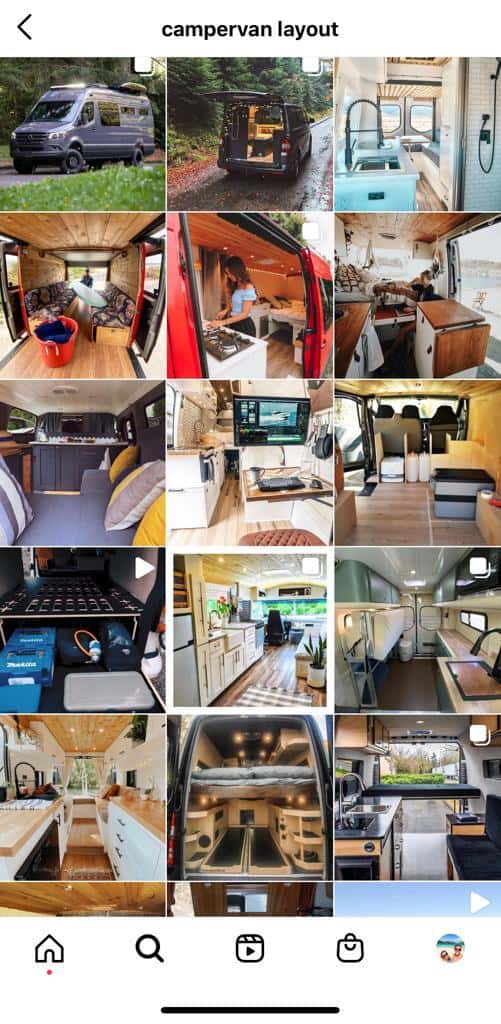
Using an online tool like Pinterest, you can create mood boards that express your style.
Not sure what your style is? That’s fine! As you prepare to build your van, slowly acquire the items you need. You’ll know exactly what type of design and layout works for you by doing this.
Once you have your board on Pinterest, make a folder on Instagram to store all of your favourite designs there. I’ll let you know that while these sites have a lot of information, they can be overwhelming.
Use these platforms as sources of motivation, but don’t let them distract you from taking action.
Measure Your Van
It’s now time to take some rough measurements after you’ve bought a van. It’s usually easier to measure the van yourself than to look for dimensions for your model online.
A Mercedes sprinter, for example, has many different dimensions for each model. This gets even more complicated with different years.
Keep in mind that your measurements are only approximations, not precise. All vans have a lot of curves, and they aren’t all square boxes.
If you’re measuring an empty van, also keep in mind that adding insulation will reduce your size by up to 30mm on each side.
Design Your Layout
Start with some graph paper and draw out the floor of your van. It doesn’t have to be perfect, but you want it to look about right. Any doors or windows in the van should be noted.
Placement of Main Items
Chances are, the majority of your room will be occupied by your bed and mattress, making it one of the most essential elements to get right.
Aside from that, the placement of the electrical, gas, and plumbing systems is next on the list. For safety reasons, you should put propane tanks inside a closed box and have a vent to the outside.
You may want to have some sort of central table and seats, but make sure they won’t block any plumbing and electrical systems.
Here is a list of items you will need to take note of
- Batteries, charge controllers, and inverters should not be placed next to any fuel tanks due to the risk of an explosion.
- A 12v refrigerator should have at least 20 – 40mm of space surrounding the vent area to improve efficiency.
- ‘If you don’t want to go stealth, utilize trailer hitches and roof racks.
- Whether you have a high ceiling or not, there’s always space for a vent fan. Place it far away from any window openings for best airflow for optimum ventilation.
- Consider mixing as many things as possible. A bed may be used as a sofa or a workstation. A toilet, for example, maybe incorporated into a chair or concealed below the seating.
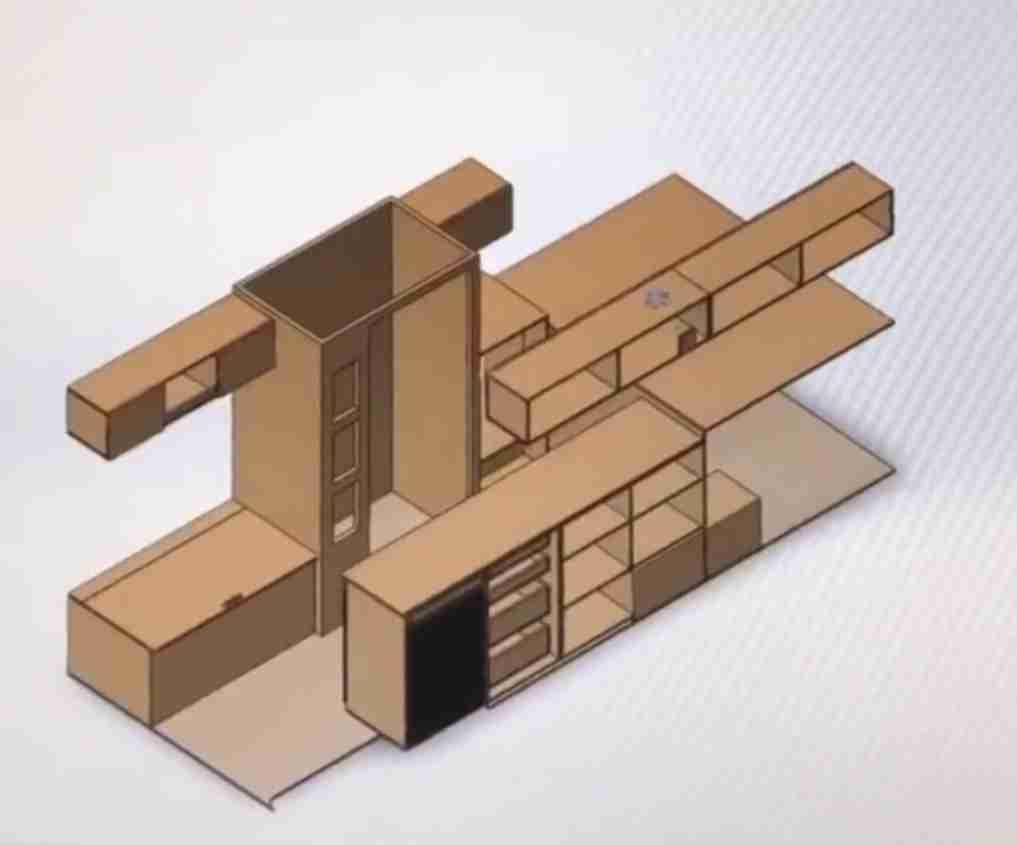
Van Payload
Many people overlook the significance of weight when planning their van build. Payload is the weight of what you can carry, and failure to recognize this could be dangerous.
Think about how much your van will weigh after adding insulation and other appliances. Also, consider even weight distribution: Where should items such as batteries and propane tanks go? Will your van handle that kind of load?
You don’t want your van to be too heavy.
Overwriting the payload may dramatically lower the vehicle’s lifespan and is dangerous. Before you begin your project, we recommend getting your car weighed at a weigh station to see how much weight you’ll have to work with.
Excessive amounts of wood, tile and even granite countertops are becoming increasingly popular among van owners!
Consider adding leaf spring assists to your van if it sags or you’ve exceeded the weight limit.
Weight Distribution
Aside from weight, you’ll want to distribute the weight throughout the van evenly. This will result in the best gas mileage and prevent your tires from wearing out on one side.
Water tanks, batteries, and completely loaded refrigerators will be some of the heaviest things in your vehicle.
If at all feasible, place these things on opposite sides of the vehicle.
Keep your big stuff as low to the ground as possible because it will lower the vehicle’s centre of gravity and improve handling.
Test The Layout
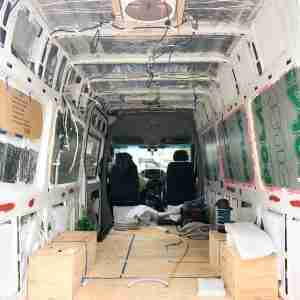
After you’ve completed your van and are pleased with the design, it’s time to see how it performs in person! Grab a roll of masking tape and go out to your van. When placing interior objects like the fridge, bed, wardrobe, and storage during your design measurements, lay the tape on the ground to match. Leave the tape on the floor during the build process to help show you your design will work.
If you have already purchased your items, you can take them out to the van and arrange them in the interior to better comprehend how everything will fit together. Some people make cardboard or plyboard stand-ins of their interiors to assist with this procedure.
If you don’t have a van yet, you may also perform this at home or driveway!
You may be shocked by how much (or little) space you have to walk around in.
Keep your ideas fresh by being flexible and ready to start over if need be.
